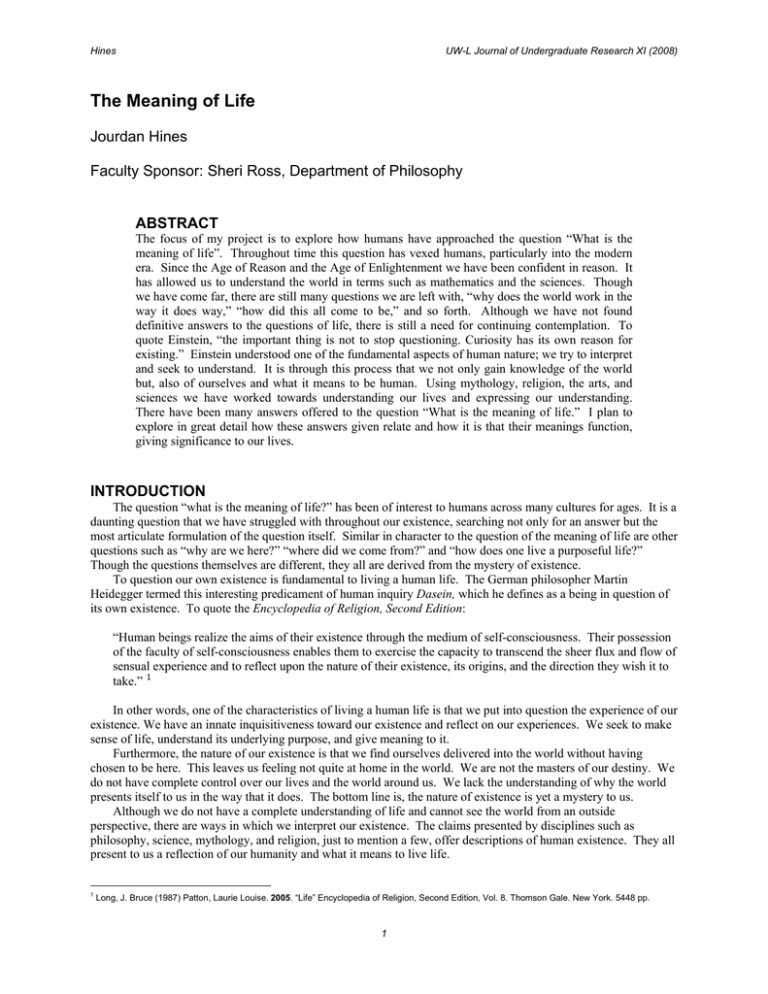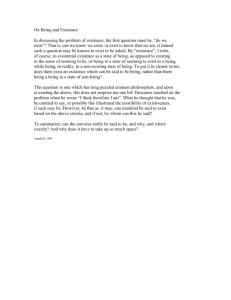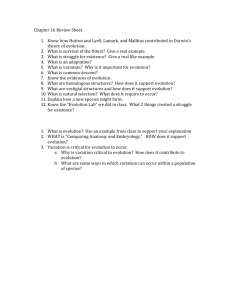The Meaning of Life ABSTRACT Jourdan Hines
advertisement

Hines UW-L Journal of Undergraduate Research XI (2008) The Meaning of Life Jourdan Hines Faculty Sponsor: Sheri Ross, Department of Philosophy ABSTRACT The focus of my project is to explore how humans have approached the question “What is the meaning of life”. Throughout time this question has vexed humans, particularly into the modern era. Since the Age of Reason and the Age of Enlightenment we have been confident in reason. It has allowed us to understand the world in terms such as mathematics and the sciences. Though we have come far, there are still many questions we are left with, “why does the world work in the way it does way,” “how did this all come to be,” and so forth. Although we have not found definitive answers to the questions of life, there is still a need for continuing contemplation. To quote Einstein, “the important thing is not to stop questioning. Curiosity has its own reason for existing.” Einstein understood one of the fundamental aspects of human nature; we try to interpret and seek to understand. It is through this process that we not only gain knowledge of the world but, also of ourselves and what it means to be human. Using mythology, religion, the arts, and sciences we have worked towards understanding our lives and expressing our understanding. There have been many answers offered to the question “What is the meaning of life.” I plan to explore in great detail how these answers given relate and how it is that their meanings function, giving significance to our lives. INTRODUCTION The question “what is the meaning of life?” has been of interest to humans across many cultures for ages. It is a daunting question that we have struggled with throughout our existence, searching not only for an answer but the most articulate formulation of the question itself. Similar in character to the question of the meaning of life are other questions such as “why are we here?” “where did we come from?” and “how does one live a purposeful life?” Though the questions themselves are different, they all are derived from the mystery of existence. To question our own existence is fundamental to living a human life. The German philosopher Martin Heidegger termed this interesting predicament of human inquiry Dasein, which he defines as a being in question of its own existence. To quote the Encyclopedia of Religion, Second Edition: “Human beings realize the aims of their existence through the medium of self-consciousness. Their possession of the faculty of self-consciousness enables them to exercise the capacity to transcend the sheer flux and flow of sensual experience and to reflect upon the nature of their existence, its origins, and the direction they wish it to take.” 1 In other words, one of the characteristics of living a human life is that we put into question the experience of our existence. We have an innate inquisitiveness toward our existence and reflect on our experiences. We seek to make sense of life, understand its underlying purpose, and give meaning to it. Furthermore, the nature of our existence is that we find ourselves delivered into the world without having chosen to be here. This leaves us feeling not quite at home in the world. We are not the masters of our destiny. We do not have complete control over our lives and the world around us. We lack the understanding of why the world presents itself to us in the way that it does. The bottom line is, the nature of existence is yet a mystery to us. Although we do not have a complete understanding of life and cannot see the world from an outside perspective, there are ways in which we interpret our existence. The claims presented by disciplines such as philosophy, science, mythology, and religion, just to mention a few, offer descriptions of human existence. They all present to us a reflection of our humanity and what it means to live life. 1 Long, J. Bruce (1987) Patton, Laurie Louise. 2005. “Life” Encyclopedia of Religion, Second Edition, Vol. 8. Thomson Gale. New York. 5448 pp. 1 Hines UW-L Journal of Undergraduate Research XI (2008) Given the variety of definitive answers offered for the question “what is the meaning of life?” we have not come up with one universally accepted answer. However, through the process of questioning and the desire to understand our existence, we can gain insight into how we interpret existence and choose to give meaning to life. This paper is not intended to present a definitive answer to the meaning of life or suggest that there is only one conclusion. Instead it is meant to look at different perspectives of how we interpret life and furthermore distill what these perspectives have in common. Because there has been such a wide variety of suggested answers to the meaning of life, within this paper I will be focusing primarily on science, religion, particularly Buddhism and Christianity, and philosophy. I will first address what these disciplines propose the nature of human existence as well as their proposed goal or purpose of living a human life. In addition, I will also show how these interpretations are fundamentally dependent upon a reflective awareness of existence and that this type of awareness is the foundation for developing a meaning of life. SCIENCE For centuries humans have used different perspectives to articulate the experience of life, struggling to understand their existence. These perspectives have changed and evolved greatly throughout the ages. In the beginning, myth and religion were the predominant ways to interpret life and give meaning. They functioned to answer such questions as “why are we here?” and “where did we come from?” They provided a spiritually based purpose for the meaning of life. Science could easily be argued to hold one the prevailing interpretations of existence for the Western worldview. It has offered us a rational explanation for existence as well as the mechanical structure of the world we live in. It has been extremely beneficial tool, speaking from a technological standpoint, and has heavily influenced the evolution of civilization into and through the modern era. Science has changed our understanding of reality greatly. What was once strictly mythological and religious understanding has evolved to include a more rational and logical approach. Most of the progress made in understanding and interpreting the world through this approach has been almost exclusively within the last few centuries and some of the most amazing advances, such as the theory of relativity, have been made within the past few decades. The scientific perspective of life has been defined through the scientific method by either one, presenting a rational hypothesis and then finding evidential support or two, beginning with a set of data observed and drawing from it the most logical explanation. To the question “why are we here?” science maintains that humans are one of many species on an evolutionary path through time which started from the big bang. For example, here is a brief summary from a scientific explanation of life excerpted from John Cottingham’s, On the Meaning of Life: “About fourteen billion years ago, the cosmos – all that there is, including matter, radiation, space and time – began, exploding from a tiny concentration of matter-space-energy. It expanded very rapidly. Later, gravitational effects caused matter to clump into hydrogen masses (galaxies, stars) and the hydrogen to start fusing into helium. Explosions caused new heavier elements, which formed into planets. On at least one planet, a self-replicating molecule arose. The descendants of this molecule evolved into living organisms, which diversified into all kinds of plants, animals, microbes et., all solely as a result of natural selection (a totally blind process, operating via random mutation plus a constant struggle for survival. After millions of years one such species became intelligent.” 2 This perspective has been pieced together from the detailed analysis of fossils and studying various attributes of the cosmological mechanics such as the fact of its expansion. Many scientists believe that the purpose of human life is self determined and granted through the ability to create a rational comprehension of the world. It is thus our goal to further develop our understanding of the world. Stephen Hawking, one of the leading cosmologists of modern times, believes that once we understand the underlying structure of the universe and how it works it will then be possible to answer why it is the way that it is. In this sense, science seeks to progress categorical knowledge about the world, enabling a fully developed explanation of existence. 2 Cottingham, John. 2003. On the Meaning of Life. Routledge. New York. 41-42 pp. 2 Hines UW-L Journal of Undergraduate Research XI (2008) CHRISTIANITY For Christianity answer the meaning of life is based upon the notion of God, the creator of the world and all of existence. The human life is to be lived with faith and devotion to God. “In recognition of the fact that life is a divine dispensation, the believer does not live for himself, nor primarily for his fellow creatures, but for his creator and redeemer (Rv. 14:7f., Gal. 2:19)” 3 The Christian notion of God is that he is incomprehensible in the traditional sense of rational thought and understanding. This is because conceptual knowledge of God from human understanding is limited. Concepts are the only tools available for perceiving or comprehending him, which falls short of describing the ultimate nature of his being. It is thus that God’s intentions and plans for his creation also obscured from human knowing. Because human concepts lack full comprehension of God and his plan, humans must put trust in him as their creator. This trust is called faith. To quote John Cottingham on the thirteenth century theologian Thomas Aquinas, “faith, or trust, supplements the deficiencies of the other faculties.” 4 Although humans cannot fully grasp God’s ultimate intent for his creation, a life of faith and devotion to him is considered part of the human purpose for living life. Moreover, the act of faith alone is not the sole purpose for the Christian life. Along with faith is also sought the morally virtuous life. “What good is it, my brothers, if someone says he has faith but does not have works? Can that faith save him? If a brother or sister has nothing to wear and has no food for the day, and one of you says to them, “Go in peace, keep warm, and eat well,” but you do not give them the necessities of the body, what good is it? So also faith of itself, if it does not have works, is dead” James 2:14 It is the Christian’s duty to commit acts of good and avoid sinful deeds. This is because when the mortal life has ended, only those who are worthy shall be rewarded for their efforts. “we aspire to please him whether we are at home or away. For we must all appear before the judgment seat of Christ, so that each one may receive recompense, according to what he did in the body, whether good or evil.” 2 Cor 9, 10 Mortal existence for Christians, like many religions, is understood to be filled with both pain and suffering. The Christian maintains that human existence is a state of separation from God. “Although we know that while we are at home in the body we are away form the Lord…” 2 Cor 6 This is also considered the state of being fallen. In Genesis the story of Adam and Eve in the Garden of Eden depicts the fall from God’s grace when Adam and Eve eat the forbidden fruit, disobeying God’s orders. God said, “Because you have done this, you shall be banned from all the animals and from all the wild creatures; on your belly shall you crawl, and dirt shall you eat all the days of your life.” Gen 3:14 As punishment for their disobedience, humans were banished from the heavenly life with God and forced to live a mortal existence, a life filled with misery. This is the Christian interpretation of why human existence is a state of suffering. Mortal life is the consequence paid for disobeying God’s will. Although human existence is considered fallen, there is hope for those that have lived according to their faith. Redemption is possible once the mortal life has been lived accordingly, having faith in God’s plan as well as remorse for the sins committed during the human lifetime. “Since life in its truest and most efficacious form lies in the future, beyond the grave, then all present conduct is but a preparation for that eventuality. …the final analysis, this indestructible form of life is the result of divine grace (Jn. 3:16, Rom 8:1-11), extended to those who repent past sins and accept the promise of salvation (Lk. 13:3, Acts 2:38, Rom 2:4).” 5 3 4 5 Long, J. Bruce (1987) Patton, Laurie Louise. 2005. “Life” Encyclopedia of Religion, Second Edition, Vol. 8. Thomson Gale. New York. 5446 pp. Cottingham, John. 2003. On the Meaning of Life. Routledge. New York. 93 pp. Long, J. Bruce (1987) Patton, Laurie Louise. 2005. “Life” Encyclopedia of Religion, Second Edition, Vol. 8. Thomson Gale. New York. 5446 pp. 3 Hines UW-L Journal of Undergraduate Research XI (2008) Salvation occurs in the life hereafter. It is with God in a pure and ultimate form of existence, heaven. BUDDHISM Another kind of religious perspective of life is the Buddhist perspective. Buddhism is based upon the teachings of Shakyamuni Buddha who lived in India around 500 BCE. “The sole raison d'etre of the whole of his [Buddha’s] life and teachings was the identification of the human cause of human misery and the means to its permanent eradication.” 6 Through deep contemplation he developed insight into the nature of human existence and achieved enlightenment, the Buddhist term for salvation. The understanding of life that Buddha gained through his meditations is defined by the Four Noble Truths Doctrine. The first noble truth is dukkha, which means pain or suffering. In Pali dukkha carries yet broader connotations such as imperfection, impermanence, and emptiness. Dukkha describes our existence, a mortal existence, within samsara. Samsara in ways is similar the Christian perspective of human existence, for they both believe that life is filled with pain, suffering, sickness, and death. However, for the Buddhist, samsara is considered to be a cyclic existence of birth, death, and rebirth. Whereas the Christian believes the mortal life is a one-time occurrence. The second noble truth is samudaya. It describes the arising or origin of dukkha. The cause of suffering is attributed to “thirst” or “craving.” The cravings are for things such as sensual pleasures, power, or ideals. These feelings of desire perpetuate suffering and the existence within samsara. Often times humans are not content with the world as it is and therefore desire for things to be otherwise. The third noble truth nirodha is the cessation of dukkha. This is the release from the state of mortal existence within suffering and is also known as the Buddhist salvation of nirvana. Nirvana is achieved when the cravings that cause suffering are completely ceased. It is then that the ultimate nature of reality can be experienced purely and uninhibited. Thus nirvana is not a place but instead a state, an awareness of existence. The term nirvana represents liberation from human existence of suffering into enlightenment of the ultimate nature of existence. The fourth noble truth is magga, which means “the path.” It is the way leading to the cessation of dukkha. It is a doctrine that gives instruction on how to live a Buddhist life. The path is the core of the Buddha’s teachings and focuses on the release from samsara into nirvana through enlightenment. The Buddhist calls this salvation attaining Buddhahood. The word Buddha itself means “the enlightened one.” Buddha, himself, used the word tathata when referring to enlightenment, which means “reality as it is”. Enlightenment is the experience of ultimate truth. It is a pure form of existence, whereas the normal way of living a human life is clouded by an inaccurate perspective of reality, much like a mirage in the distance can appear to be real but in all reality, there is nothing there. The Buddhist’s idea of salvation has a different approach then the Christian. The Christian believes in mutually exclusive modes of existence, where salvation takes place in heaven, completely separate or apart from mortal existence on earth. The Buddhist, on the other hand, believes that salvation happens within the same reality but there is a change in the perspective of viewing reality. As Nagarjuna, the Buddhist systematizer of the first century B.C.E. puts it, “There is no distinction whatsoever between samsara and nirvana and there is no distinction whatsoever between nirvana and samsara.” 7 The goal of the human life, for the Buddhist, is to seek enlightenment. Life’s purpose is to cultivate a deeper understanding of the nature of existence or as the Buddha put it, to see “reality as it is”. The means for fulfilling this goal is through developing the mind in a variety of ways in order to purify its perspective of experience and existence. This is done primarily through meditation involving right concentration and mindfulness. The Dalai Lama says, “The mind is definitely something that can be transformed, and meditation is a means to transform it. Meditation is the activity of familiarizing your mind with something new. Basically, it means getting used to the object on which you are meditating.” 8 6 7 8 Long, J. Bruce (1987) Patton, Laurie Louise. 2005. “Life” Encyclopedia of Religion, Second Edition, Vol. 8. Thomson Gale. New York. 5448 pp. Streng, John. 1995. The Experience of Buddhism: Sources and Interpretations. Wadsorth Belmont. 148 pp. (The) Dalai Lama. 2000. The Meaning of Life. Wisdom Publication. Boston. 34 pp. 4 Hines UW-L Journal of Undergraduate Research XI (2008) What he means by this is that the process of meditation exercises the mind and through practice, enables it to better isolate and understand the conceptions of reality that it creates. Meditation helps to focus the mind, keeping it free from wandering thoughts. It is through meditation that right concentration and mindfulness can be cultivated. Right concentration can also be regarded as one-pointedness of mind, it is analogous to using a magnifying glass for focusing the sun’s rays. On their own, the sun’s rays can only warm the surface of an object but when the magnifying glass is used to intensify the rays, they can then burn. Right concentration gives the mind focus to direct thoughts and gain insight into the nature of existence. Mindfulness is the activity of non-conceptual awareness. It is the ability to see the phenomenal world presented as it is without the mind being influence by preconceived notions. The mind naturally tends to project its own perspective upon the world and deludes itself from perceiving what is more true to the nature of reality. Through cultivating mindfulness the mind acts with openness toward the experience of existence. CONCLUSION These interpretations of life define what human existence is and its purpose. They offer a meaning of life. Moreover, they are all fundamentally dependent on a conscious awareness of existence itself. In other words, the different meanings of life offered are in response to life, stemming from an existential grounding. As Heidegger terms it Dasein, a being who’s own being is at issue. This is unlike what we observe from many creatures within the animal kingdom. The main concern throughout their existence appears to be merely survival frowm day to day. Though in many respects humans have this same concern for survival, on the other hand, humans go beyond and also ask question about themselves and the world they live in. As we have looked at a scientific, Christian, and Buddhist answer to the question of what life is and it is clear that they all have a very different approach in their interpretations. However, they are all concerned with the same fundamental aspect, the experience of life and existence itself. From these perspectives of what human life is, is defined how a human life should be lived. Science seeks to gain knowledge and understand the universe. Christianity is based on the mortal relationship with God. Buddhism focuses on the developing of the mind. REFERENCES Cottingham, John. 2003. On the Meaning of Life. Routledge. New York. 21, 22, 41-42, 93 pp. (The) Dalai Lama. 2000. The Meaning of Life. Wisdom Publication. Boston. 34 pp. Long, J. Bruce (1987) Patton, Laurie Louise. 2005. “Life” Encyclopedia of Religion, Second Edition, Vol. 8. Thomson Gale. New York. 5444, 5446, 5448 pp. Pilarczyk, Daniel E. 1992. St. Joseph Edition of The New American Bible. Catholic Book Publishing Co. New York. Streng, John. 1995. The Experience of Buddhism: Sources and Interpretations. Wadsorth Belmont. 148 pp. 5



